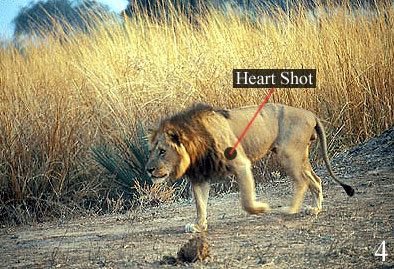Firearm Selection and Shot Placement
For the most part, lion can be regarded as soft skinned game. They have a relatively light bone structure, thin skin and are not that big an animal (they weigh less than a big sable or gemsbuck). Every experienced lion hunter from Taylor to Rushby has noted that, in common with other felines, they are particularly susceptible to ‘shock’ (hydrostatic effect), and that a high velocity rifle is more effective than a low velocity rifle of bigger calibre. Taylor noted that the .416 Rigby and .425 Westly Richards would crumple a charging lion so much more effectively than his beloved .500/.465 or even a .577. Rushby, when dealing with the man eaters of Njoma preferred his 9,3 (with continental high velocity loads giving a velocity of 2350fps) over a departmental .404 (with the old English load producing 2150fps). The reason was simple. The 9,3 put lions down like the .404 only dreamed about, and Rushby was somewhat apprehensive about having to go back to a .404 when he was forced to sell the 9,3. ‘Yank’ Allen, the (only?) full time professional lion hunter stuck to a .303 rifle with MK7 ammunition after a few close calls with a .450/400. This susceptibility to shock is usually attributed to a highly developed nervous system, but large, fragile lungs, coupled with a very large heart and big blood vessels (for its size) must surely also be contributing factors.
 |
| A far more usual shot angle than the Classic Broadside. Note how the mane makes the chest look excessively deep. |
Consequently, in many countries lion are classified as large soft skinned game and may be legally hunted with rifles suitable for sable, eland and giraffe. Most of the time a rifle in the .300 magnum class is perfectly suitable, particularly when hunting in daylight and being backed up by somebody with a heavier rifle. For hunting at night or following up a wounded animal something considerably heavier is definitely needed. For night shooting, something in the order of a .338 Win Mag or a 9,3x62 should be regarded as the minimum. Here bullet selection is important, since rapid destruction of the lungs/heart is vital, and yet penetration may be crucial. Bullets such as the Nosler partition really stand out as a truly great design for lion, especially in the smaller calibres.
For following up a wounded lion, nothing under the .400 class of rifles can really be considered satisfactory. In their modern loadings the .404 and .416 Rigby are very effective, alongside their newer counterparts such as the .416 Remington. Again, bullet selection is the key to satisfaction and safety. A charging lion is definitely NOT a soft-skinned animal, and light-for-calibre or frangible bullet designs are going to fail dismally. Premium softpoints such as the 'Barnes X, Woodleigh ‘Weldcore’ or Stewart’s Core Bonded bullets (or a host of other semi custom premium softpoints) are a better choice for this than the ‘Partition’ style bullets since the massive chest muscles have to be penetrated before the vital organs can be reached. A lion tensed up to fight probably offers nearly as much resistance to a bullet as a Cape Buffalo, and bullet selection for this specialised task needs to be much the same. Solids, however, should NOT be used. The shock and tissue damage created is simply too small to conclude matters quickly enough. A lion can reach 80km/h (50mph) in a charge and is a relatively small target:- Stopping it - dead - is a top priority.
As with every animal, bullet placement is important. No amount of foot-pounds of energy can make up for a bullet in the stomach and the lion’s famed susceptibility to ‘shock’ definitely does not apply to gut shots or bullets through the leg etc. The brain is a tiny target, located behind the eyes if the lion is looking directly towards you. From any other angle the brain is an extremely difficult target since the mane obscures the head and even the ears, making it virtually impossible to determine where the skull actually is. Even when the head is clearly visible (such as on a lioness or maneless male), hunters tend to shoot too high. The whole top of the skull is covered by massive muscles to work the jaws and the brain is located several inches lower than one would normally expect (see photo 1). Consequently the brain shot is to be avoided if at all possible.
|